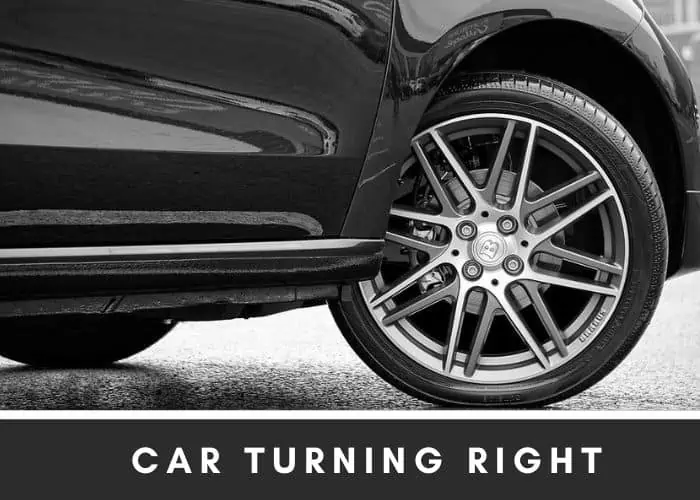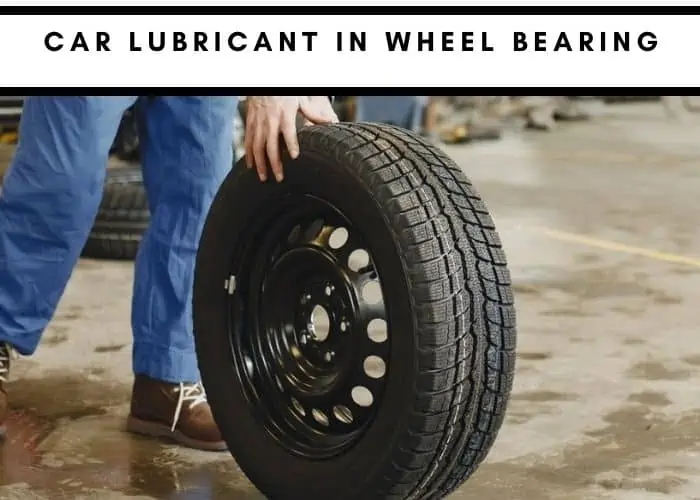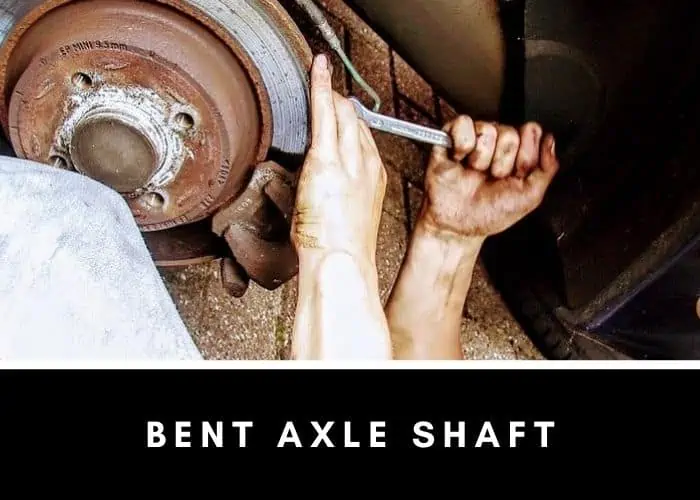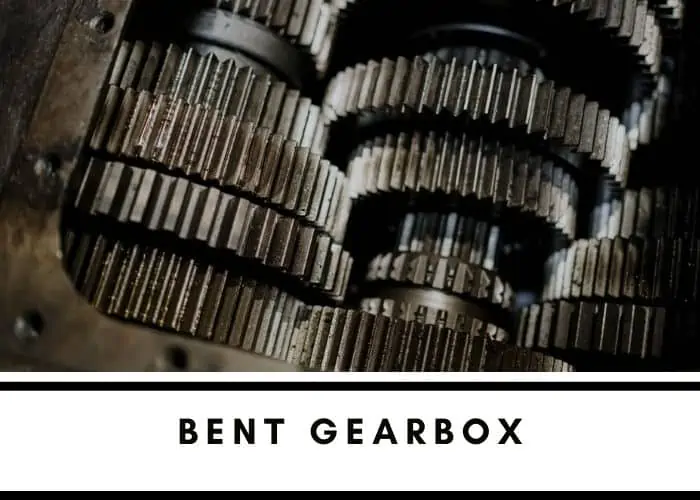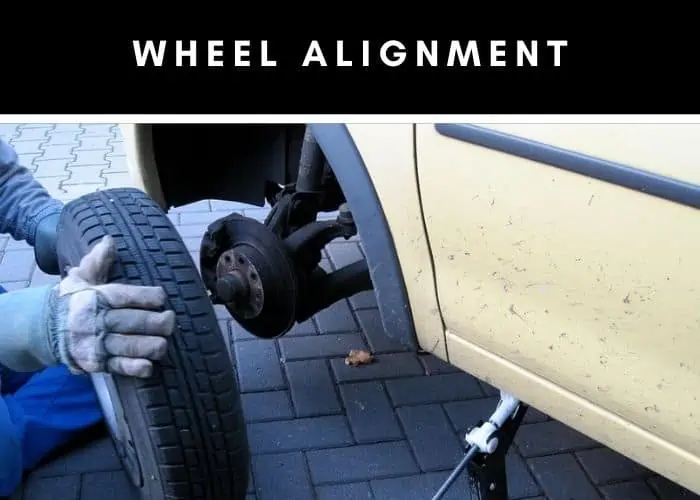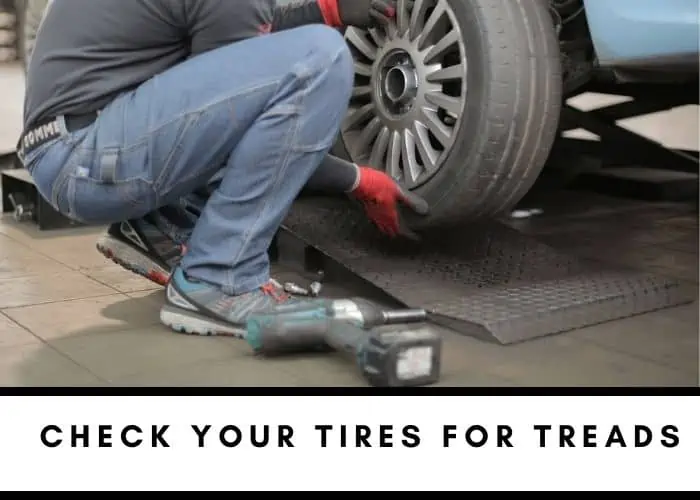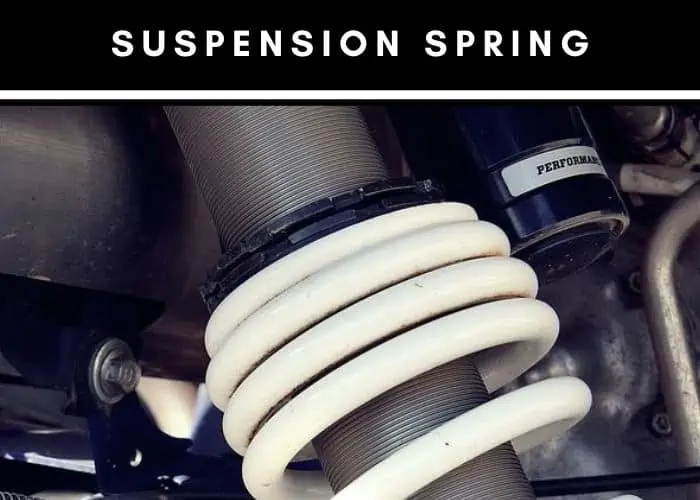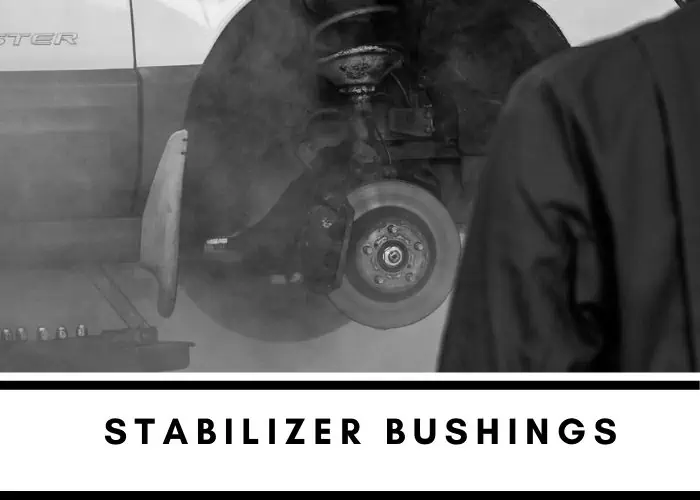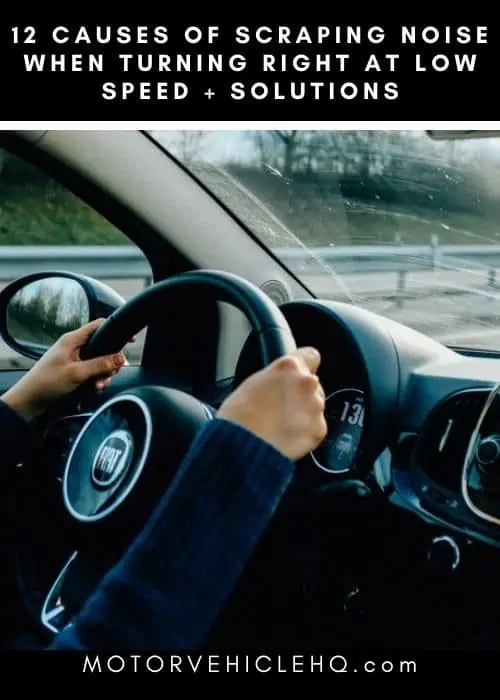If you hear a scraping sound when turning at low speeds, it’s a cause for concern. There are many possible causes, some of which are minor and easy to fix, while others can be severe and even dangerous.
Whether the problem is simple or severe, you should check it out right away by a professional mechanic since ignoring it can lead to a much bigger issue.
A scraping noise can be caused by a couple of things. The most common is a bad wheel bearing. This is when the bearings in your wheels are damaged, and you hear them scraping against the metal that holds them in place.
So if you’re hearing that scraping noise when turning your car at low speeds, here are all the possible reasons why:
#1. Worn Out CV Joints or U-Joints
A CV joint is part of the drive axle. It allows wheel rotation while keeping the axles parallel, which is necessary for steering.
The CV joint also allows the gears in your transmission to turn when driving over rough terrain without transferring too much shock and vibration to your car’s body.
If a CV joint fails or wears out, it can cause terrible scraping noises when turning right at low speed or any speed when going straight on a flat surface (this may not be immediately noticeable as other components could be causing the noise).
If this happens to you, bring your car to an auto repair shop as soon as possible before more damage occurs.
Car lubricant is crucial for your car’s wheel bearings. Without it, the bearings will not work properly and will wear out quickly. The lubricant keeps the bearing surfaces from scraping against each other and allows them to move smoothly.
#2. Excessive Lubricant in the Hub Bearing Assembly
Check your hub bearing assembly. The hub bearing assembly is a part of your vehicle’s steering system that connects the steering knuckle to the steering wheel.
It also contains oil as a lubricant to keep everything running smoothly. However, too much oil can cause premature wear on these parts and lead to excessive noise when turning right at low speeds.
If you notice this issue, check your car manual for instructions about adjusting or removing excess lubricant inside your hub bearing assembly (or have an auto-service technician do it for you).
#3. Failing Wheel Bearing
If there’s a scraping sound when turning right at low speed, your wheel bearing may be failing. Wheel bearings are small pieces that support the rotating shaft of a wheel and allow it to turn smoothly.
Without them, a vehicle cannot move forward or backward. If this part fails, it can cause the tires on one side (typically the rear passenger) to rub against their hub or brake drum, making loud noises when turning right at low speeds (and sometimes also when starting from a stop).
The axle shaft is a piece of metal that connects the wheels to the drivetrain. A bent axle shaft can happen when you hit something, like a curb or another vehicle.
#4. Bent Axle Shaft
An axle shaft is the part of your vehicle that connects your wheels to the transmission. When you turn right, this shaft rotates and drives power from the engine to your tires.
A bent axle shaft will cause noise when you turn right at low speeds because it has been physically damaged and is no longer spinning smoothly in its casing. There are many causes of a bent axle shaft:
- Running over something hard enough to damage the metal,
- Under-inflated tires, causing excessive strain on one side of your car.
- A rough patch in the road causes one wheel to hit first before the other.
#5. Damaged Steering Knuckle
The steering knuckle is the part of your car’s suspension system that connects the steering wheel to your tires.
It’s made of rubber, steel, and aluminum. It absorbs energy during collisions. The steering knuckle can become damaged when it hits a curb or other obstacle while turning right at low speeds.
It is why you often hear scraping sounds when turning right at low speeds due to wear on these parts.
If you notice excessive scraping sounds when turning right, take your vehicle into an auto repair shop for diagnosis before driving again.
#6. Bent Steering Components
Many parts make up the steering mechanism, but the most common problems are the steering knuckle and tie rod ends. It can cause a scraping noise when turning at low speeds.
A bent gearbox is a condition that can affect your car’s transmission. It happens when the gears get so worn down that they are no longer straight, and instead curve or bend. This causes them to scrape against each other, which results in a lot of noise, friction, and damage to your transmission.
If you hear a scraping noise when turning right, it could be due to:
- A bent steering rack or gearbox.
- Bent steering arm or column.
- Bent tie rod end.
#7. Stuck Brake Caliper
If you hear a scraping sound when turning, it’s likely the brake caliper causes it. Brake calipers are cylinders that squeeze the brake pads against your rotors when you step on the brake pedal.
If your car’s brakes get stuck in this position, they won’t be able to retract — and won’t let you drive anywhere.
Even if your brakes are working and aren’t making noise, it’s crucial to check for any signs of damage or wear and tear. It can help prevent expensive repairs from happening later.
#8. Worn Out Brake Pads
Worn-out brake pads are the most likely culprit for this problem. Brake pads have a lifespan of about 20,000 miles.
Replace them when they wear down to the point where they are thin enough to cause damage to the rotor.
When you hear this scraping noise, it is a squealing sound from your brakes. If you hear this noise only when turning right at low speeds, then there’s a good chance that you need to replace your front brake pads.
#9. Aftermarket Suspension Kit
Aftermarket suspension kits are a common culprit for scraping noises when turning right. These kits improve vehicle handling and performance but can also make it difficult to navigate tight turns.
When turning right at low speeds, the increased resistance of an aftermarket suspension kit can cause the steering knuckle to rub against the inner fender or wheel well. This friction creates a loud scraping noise that is hard to ignore.
Modern vehicles use computer systems that monitor engine performance, tire pressure levels, and other essential statistics in real-time. If you experience a scraping noise when turning right at low speeds but don’t have any signs of wear on your tires or steering components, there’s a problem with one of these systems—and fixing it may require replacing parts like air filters or spark plugs.
#10. Worn Out Strut Mount Assembly
The strut mount assembly is a part of the suspension system, which connects the steering knuckle to the upper control arm.
The mount assembly helps keep your car stable when turning by absorbing vibrations from driving on rough roads and ensuring that your wheels stay aligned.
It is part of the front suspension system, which helps maintain proper alignment in all directions while driving at high speeds or through potholes.
It also prevents excessive wear on other parts like ball joints or ties rod ends. It absorbs shock energy created during sudden changes in direction at low speeds (turning right onto an unpaved road) or over bumps in the road surface (driving over railroad tracks).
#11. Loose Wheel Lug Nuts
Loose wheel lug nuts are a common cause of the scraping sound. If your wheel lug nuts are loose, it will result in vibrations and other issues.
Also, if you have one or more loose wheel lugs, this can cause damage to your vehicle’s axle.
You should check your wheels for any signs of damage after driving on bumpy roads or pothole-filled roads.
Wheel alignment is the process of adjusting the angles of your car’s wheels so that they’re set up correctly. This ensures that your tires are wearing down evenly, and that you’re getting the most out of their tread. Alignment is important for safety, too. When your wheels are out of alignment, it can cause poor handling.
#12. Faulty Wheel Alignment Settings
If your tires are misaligned, they could be rubbing against body panels or hitting each other as they spin. And that means extra wear on your tires and car parts — and worse if it causes an accident.
So if you hear unusual scraping noises when turning right at low speeds, look at those wheel alignment settings. Your mechanic can help diagnose any issues.
How To Diagnose Scraping Noise
If your car is making a scraping noise when you turn at low speed, the culprit might be one of the suspension components (tie rods, wheel bearings, ball joints).
The good news is that a visual inspection can usually determine if you need to replace any of these parts. You may have to get a wheel alignment to fix the scraping noise when turning right at low speeds.
Visual Inspection of the Wheel Alignment
The next step is to inspect the wheel alignment visually. Wheel alignments are measured in millimeters, so a good way to check your car’s alignment is with a ruler or other measuring device.
A properly aligned car body should be parallel with all four wheels. A visual inspection of your vehicle will tell you whether the front or back tires are off-center by a significant amount.
If they are out of alignment more than 1/2 inch (13 mm), then it’s likely that your tires need to be realigned or replaced.
Check your tires for tread. You can do this by looking at the tire’s grooves. The grooves should be deep enough to cover most of the tire’s width. If they’re not, it means your tires are worn out, and you need to replace them.
Check the Tires
- Check the tire treads. If there is not enough tread on your tires, or if your tires are bald and have only a few treads of rubber left, you may be experiencing noise when turning right at low speed.
- Check the tire pressure. Air leaks can cause extra friction between the road and your tires—especially if you’re driving over potholes or other rough surfaces—which will make it harder for your vehicle’s suspension system to absorb shocks as efficiently as possible. It can lead to scraping sounds when turning right at low speeds (as well as other noises).
- Check the tire alignment. If one side of your car is lower than another due to misalignment issues with one or more wheels, this can cause scraping noises. Because of uneven weight distribution between each wheel segment, this imbalance could lead to chipping/cracking along any poorly aligned components.
Inspect the Tie Rod Ends and Control Arm Bushings
Inspect the tie rod ends and idler arm. You can locate these two components on the front suspension of your vehicle, with the tie rods on either side of the tire under a protective boot.
If these parts are damaged or worn out, they may be causing scraping noises when turning right at low speeds.
The second step is inspecting your control arm bushings. Control arm bushings are rubber cups that fit around a metal rod called a control arm– which connects to both wheels — and help keep vibration from being transferred from one wheel to another during turns and sudden stops.
Deteriorated control arm bushings can cause a grinding sound because there’s extra friction between the control arms and their respective bearings as they move together to enable this action; replacing worn-out ones will eliminate this problem.
Inspect the Ball Joints
Determine what is causing the scraping noise by inspecting the ball joints. Ball joints are rubber-sealed joints that connect the steering knuckle to the steering arm.
They can wear out or break over time, and their failure often causes a knocking sound when driving at low speeds.
The easiest way to inspect your car’s ball joints for wear is by simply jacking up your vehicle and rotating each wheel one full turn in both directions (clockwise and counterclockwise).
If there is any abnormal movement or play in the joint, then it will likely need a replacement right away.
The purpose of suspension springs is to allow vehicles to move smoothly while supporting their weight. Suspension springs allow you to drive your car over rough roads. They also help reduce wear on your tires and improve fuel economy.
Inspect Your Suspension Springs
Visually inspect your car’s suspension springs. The suspension springs are a common cause of scraping noise. The suspension springs are located in the front and rear of your car.
They’re responsible for keeping the tires in contact with the road. If a suspension spring is damaged, it may not keep your tire from hitting the chassis when making sharp turns at low speeds.
If you find any signs of damage or wear on your vehicle’s suspension springs, contact an auto technician to have them replaced immediately before further damage occurs.
Solutions for Scraping Noise When Turning Right at Low Speed
If you hear a scraping noise from the front of your car when you turn right at low speed, don’t ignore it. Even if the sound is only present when turning right, there are still plenty of parts that can be causing it. Fortunately, these parts are not expensive to replace.
Solution 1: Get a Wheel Alignment To Fix the Scraping Noise
Get your vehicle’s wheels aligned. A wheel alignment involves adjusting the angles of your car’s wheels to set it to the manufacturer’s specifications.
It ensures that your tires maintain a straight line when driving straight and turning, which helps you avoid scraping noises from the tires rubbing against each other when turning right at low speeds.
Wheel alignment is crucial for safety and performance, especially if you drive over rough roads often or frequently pull heavy loads with your vehicle.
It can also improve gas mileage by reducing tire wear, especially if you have recently installed new tires on an older vehicle that had previously had no problems.
A wheel alignment requires specialized equipment and training to perform correctly without risking further damage to the suspension system or additional complications such as broken suspension parts due to misalignment issues after improper use of said equipment (such as using jacks).
Solution 2: Check the Suspension
- Check the condition of the suspension. Inspect all suspension parts, including struts, tie rods, ball joints, and bushings.
- Ensure that your vehicle’s alignment is not misaligned. An out-of-alignment vehicle can cause scraping noises because it will cause uneven tire wear on one side but not another. It may not be noticeable unless you check for it regularly as part of your car maintenance routine.
- If you are still experiencing scraping noises after performing all of these tests, it’s time to take your car in for diagnostics (including an inspection) from an experienced mechanic. The professional can pinpoint the exact source(s) of these unpleasant sounds — provide cost-effective solutions– and replace worn parts.
Solution 3: Fix or Replace the Sway Bar Link
When the left side of your car hits a bump in the road, for example, the left side of your suspension system absorbs it; in turn, it makes your tires push inward and outward as they follow along.
This motion is what allows for smooth turning in low-speed situations. But if any part of this system breaks or malfunctions (with a broken sway bar link), then there will be some interference between one side of your tire and another — and that’s when scraping noise happens.
The good news? Replacing a broken sway bar link is relatively easy. You can do most replacement work or have an auto shop do it for you.
Stabilizer bushings are used to reduce road noise, vibration and harshness. You can locate stabilizer bushings between the vehicle’s frame and stabilizer link.
Solution 4: Replace the Stabilizer Bushings
If your stabilizer bushings wear out, it is necessary to replace them. These parts are responsible for transferring weight from one side of the vehicle to another while turning.
It can be especially problematic when turning right at low speeds because there isn’t enough weight on one side of the vehicle and therefore causes excessive noise when driving over bumpy roads.
The first step in replacing these components is locating them under your car. The front ones are near where the tie rod connects with its corresponding ball joint, whereas the rear ones will be upstream from where you would find your springs and shocks (if equipped).
Next, remove any dirt or debris that may have accumulated around these parts with a brush or compressed air before further disassembly begins.
Once you’ve done this, begin by removing all nuts on each end using an impact wrench – alternatively, if no impact tool is available, then use an 18 mm socket wrench instead.
You should also inspect these areas closely for cracks or leaks resulting from age/wear; if found, consider replacing them immediately since they’re likely unsafe for continued operation.
Solution 5: Replace the Tie Rod End
The fifth solution is: Replace the tie rod end. The tie rod end is the most common cause of scraping. It’s a rod that connects the steering knuckle to the steering rack, and it usually wears out first due to its location on one side of your car.
Solution 6: Replace the Lower Control Arm
The last solution is to replace the lower control arm. It is a big part of the suspension system and you need to replace it if damaged. You will want to consult a mechanic or auto body shop, as these parts can vary depending on your vehicle’s make and model, so you need one that matches what you have.
Conclusion
As you’ve seen, there are many reasons why your car might make scraping noises when turning right. It can be hard to troubleshoot all by yourself, but we hope that by reading this guide, you’ve gained some insight into what could be causing the noise and how to fix it.
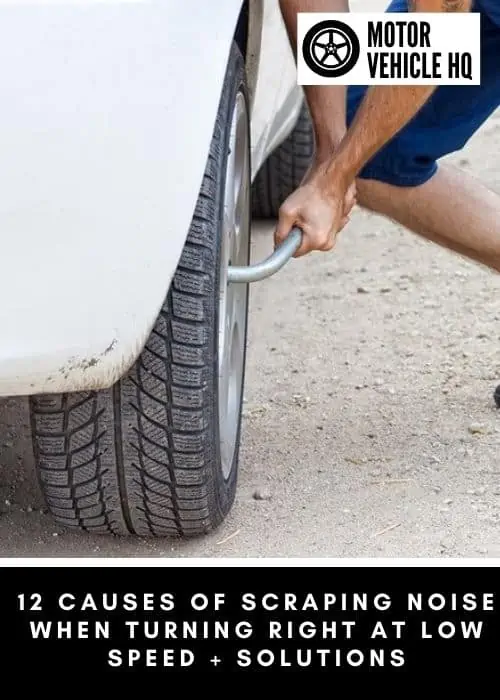

Jim Wicks is the founder of MotorVehicleHQ. With over two decades of experience in the automotive industry and a degree in Automotive Technology, Jim is a certified car expert who has worked in various roles ranging from a mechanic, car dealership manager, to a racing car driver. He has owned more than 20 cars over the past 15 years. Ask him about any vehicle you see on the road and he can tell you the make, model and year. He loves the aesthetics of all things cars, and keeps his vehicles in pristine condition.
In his free time, Jim enjoys getting his hands dirty under the hood of a classic car or taking long drives along the country roads. His favorite car? A 1967 Shelby GT500, a true classic that, according to Jim, “represents the pure essence of American muscle.”
